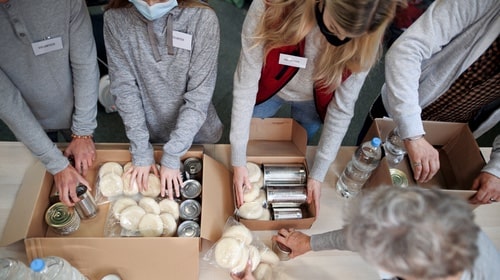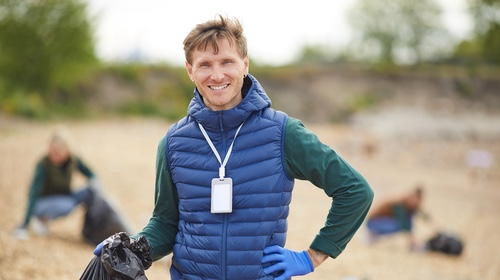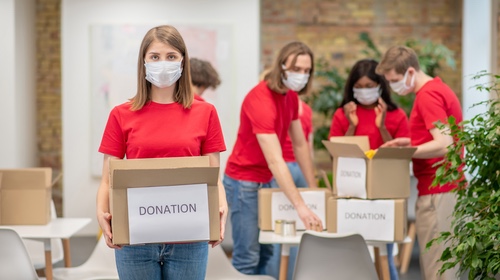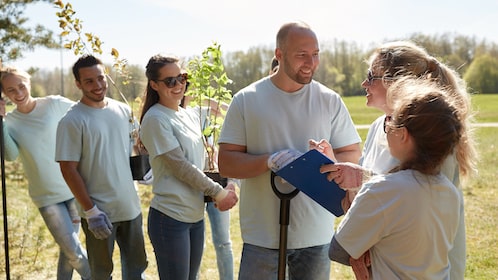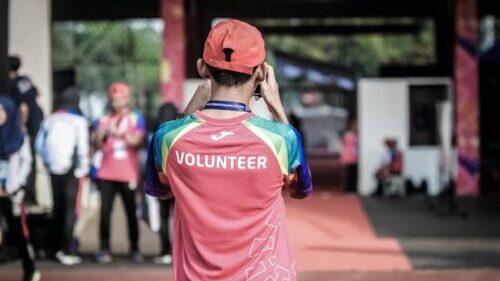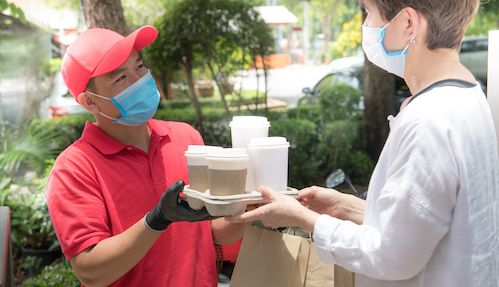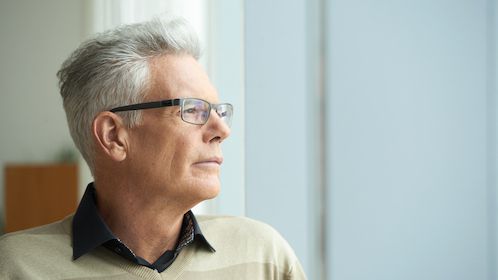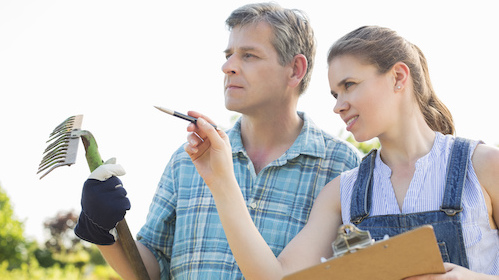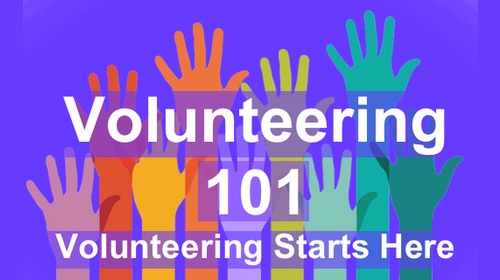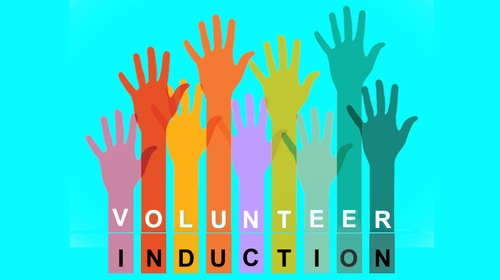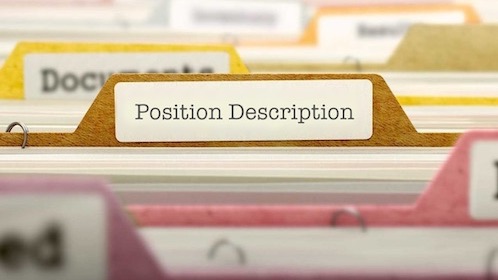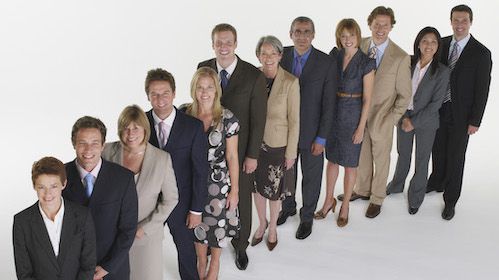ANZ Seeds of Renewal Grant Writing
This recorded webinar will take you step by step through the guidelines of the current ANZ Seeds of Renewal Round 2021.
Authored by: iClick2Learn Team
Translate Text
It’s a few key things that I wanted to start with with this program for those of you. Who and I think you know one of the the biggest things of grant programs is it’s like oh my gosh there’s maddie quick you know let’s let’s apply for this but it is so important that you actually do complete.
Your project plan now after this session and if you’re watching the recording this is also available at the bottom of the page after the session I’m going to send each of you an email and you’re going to have a draft what I call the project planning canvas and I’m also going to give you a help sheet to help you.
In particular with f triple r’s budget if you’re not familiar with it is slightly different so i’ve done a little cheat sheet that’s going to help you with that so I’m going to email those out to you and if you’re watching the recording it’s just underneath and you’re able to to download that so it is really important that you think about what your project is now seeds of renewal program has been going for quite a long time and the answer partnered with f triple r to bring this as I said to or as I said to regional rural and remote communities and and it is very much focused on looking at how that you can build a sustainable community so that can be you know strengthening what you already have and it could be creating opportunities to do things that certainly deliver medi to long-term economic benefit to the community and that contribute to economic sustainability and i think that’s the key thing with this one is just to remember who the funder is the fundraiser bank and of course that economic piece for them is actually quite important you know their premise and and uh this is just a statement as a as a grant writer and assessor i don’t know any inside information i can assure you but when i look at a funder like this I look at what’s their motivation for supporting a grant program and being a bank in this case they certainly have a real motivation to make sure that a community is strengthened through economic impacts so you know economic benefit back to the community so really make sure that you have that lens when you think about your projects if you’ve already planned your projects uh and you’ve worked out you know what benefits it delivers so those outcomes that your project is delivering go back and have a look and make sure that that you’ve got those economic benefits and those economic outcomes in your project plan that is really important if uh you haven’t already done so if you haven’t already identified it then you will actually need to think about how you’re going to to measure that and you know monitor those those impacts through the program one of the great things about actually going onto the website and i’ve got the website the f triple r website up in front of me seeds of amz seeds of renewal and I’ll just pop that link again we’ll pop that down the bottom for those watching the recording and it’s in chat now for those joining us live one of the the great things about uh grant programs that have happened in the past is you’re able to get a sense for what sorts of programs the funder has funded before and you can see here and i’ll just visually describe this just in case we do have people listening in or that do have a visual impairment on the page you’ll actually be able to find previous rounds it’s called and there are links to the different years and the types of projects and programs they’ve supported that’s really useful information because it gives you a sense for what uh not necessarily what they prefer it’s not about a preference but it’s the types of projects so what sorts of things do they do they focus on you know what sorts of community projects do they they believe are demonstrate that economic benefit so you know feel free to have a look at those noting that from year to year funders do change a focus so it’s it’s just interesting information don’t be guided by it at all but it’s interesting information for you so let’s have a look down further on the page you will find there are three tabs on the page one is called program guidelines and there’s a raft of information there and then there’s some information to help you when you’re actually gathering gathering information for your
application so i really strongly recommend that you look at this and then the third tab is the apply now and there’s some some useful resources so as I mentioned we will be going through the program guidelines and application form for those of you who have never applied to f triple r before there’s also a very useful how-to guide to navigate their grant
application online system one of the things that i always recommend people do when they found a grant that suits them is make sure that you are eligible and we’ll look at this in in guidelines in more detail but you really do need to make sure that you have that eligibility piece it’s either a legal status or a tax status eligibility it’s kind of like you know if you like the first gate the decision gate that you need to get through because if you’re not eligible you know you certainly won’t be able to apply or if you do apply you’ve you know wasted a lot of your time which is not what we want to happen so once you’ve found a grant program that is of interest you should download what I call the application kit now that is the guidelines the application form and anything else that they have mentioned in their guidelines and their application form it could be related for example to a policy there is one in the f triple r’s instance which i’ll show you a little later which is called an activity tree so i’ll get to that and show you that in a moment but the other thing that i really seriously recommend that you do read it may be duplicate information but there might be one or two things that have been added in that aren’t in the guidelines and that is any information on the page so in this case for this grant program there are some drop down boxes for example what are the program objectives and it goes through the program objectives which i will come back to now you certainly in this case I have checked and you will find that in the guidelines there’s a couple of other points as well but there is one one aspect here that’s not in the guidelines which is a volunteering opportunity so so please make sure you do read that I’ll come back to that in a moment as well so definitely read anything that the funder has on their website i picked up something the other week on a grant program that was in their faqs but wasn’t anywhere else in the docentation that said you know if you submit a risk management plan your application will be deemed more favorable like wow big news that wasn’t anywhere else so you know really make sure that you do think of what’s on their their website as part of the guidelines as i said it might be duplicate information it doesn’t necessarily hurt because it means you’re hearing the the same strong messages again but uh but it could also be new information as well so in saying that let’s go on and have a look at the guidelines and I’m watching chat as well so please feel free as we go through I’m just going to stop sharing this page please feel free as we go through ask any questions relating to this so let me just bring up this screen so what we’re we’re looking at here is the program guidelines you know does close on the 11th of august uh big hot tip plan uh for it to close on the 9th of august and give yourself a little bit of leeway we all know where grant
writers things crop up and things happen don’t they so give yourself plenty of time you don’t
want to get to the end of the hour or those hopefully it hasn’t happened to you but I certainly know people it has happened to leaving it too late and uh and hitting submit right on time and just missing out particularly that this is a regional rule remote we all know that uh that sometimes funny things can happen with our data so we want to make sure you get that in in on time and a note for those who are in uh western australia joining us and from other I think we’ve got some some uh someone from or in tasmania at the moment I should say not from but in tasmania at the moment and uh from anyone else watching the recording from another state this is victorian time the close time so I always recommend when you’re going
through guidelines that you actually have your own checklist and so this is what I would do if for example I would actually note the date and I would note that it’s actually closing at 3 pm because there’s a currently a a two-hour time difference between aest and awst and I’d actually note that that closes at 3 p.m on that date wa time so it is important it’s one of the things that we do with with different states it is important to make sure that we know the is that time that close time is it uh you know our local state time or is it is it their time always asse that it’s their time and double check with them as well it doesn’t hurt so so you will put that down on your your guidelines checklist there is some information about f triple r which is is useful to get a sense if you again if you haven’t been exposed to them before you know that the focus here is you know their programs really focus on ensuring the social and economic strength of remote rural and regional communities and you know certainly seeds
of renewal uh very very well aligns to to that purpose so there’s a couple of things that we should be really really clear on we should be really clear on why are they giving out funding i mean yes i know they’re very you know good hearted well-meaning people out there but at the end of the day they have to achieve a purpose you know there’s something that’s driving them that’s motivating them this one in particularis about I’m just going to highlight some highlight to some words here I can’t highlight them on screen so I’m just going to to read out these words to you in particular i might be able to highlight here we go is designed to help build vibrant and sustainable rural communities and it’s about ensuring the ongoing prosperity of regional australia so you know when we think about think about this program in particular you’ll see that vibrant communities and and sustainable communities are elements that we focused on further on in the guidelines so when we think about vibrant communities the way that this is described to us is that it’s about diversity and inclusiveness with strong social capital where everyone can participate to build a better life now if I was reflecting on that and reflecting on my grant program I would actually be saying well how does what I’m asking them to fund in this program how does it actually include everyone so what so what does that look like look some programs that you might apply for of course they’re specifically for your group or your organization but do you think you know this will actually give it a lot more strength when you consider let’s just say you’re you’re a club or a community group you’re actually going to get a lot more strength in your submission if you’re partnering with others to have a broader impact and the one of the key things about this program and this is an example of something i’m just going to to swap screens back to the website because i do want to show you something in particular that that has been mentioned here we go in this information here we go and i’ll just zoom in a little bit here as well so that everyone n those of you who are watching the screen and they would have seat are able to see this one of the particular things about this program is that the program and they’ve been very upfront with this it typically funds one project per region so in essence what they’re wanting to do is they’re wanting to have a program that does have a broad impact and so if we come back to that vibrant community statement this is this is really about making sure that when you’re considering what you’re applying for funding for that it broadly is looking at your community not necessarily your region although if what you’re doing has a broader approach then fantastic it’s definitely an opportunity to make sure that they are aware of that but certainly think about your community as a broader approach so i’ve just had a question and in this case sasha has asked this uh and I’ll say that because sasha certainly uh put this this question to everybody in the chat box if you would ask like to ask me something privately and confidential confidentially please then just direct it to me and uh and I’ll make sure that i address that so in this case some sasha said does the region mean the riverina or is it smaller like shires when I see region I think about when uh you know think about a benchmark so when we talk region we talk regional organizations so those regional organizations typically cover a region which is in this case the riverina region got some some wa people there and and uh great to see you on on screen there hello and so uh in that case for wa what they’re looking at is the great southern region so that’s an example when we talk regionals so so locally is your local community or lga because some communities are lga but generally speaking when we talk
about remote regional and rural communities we have an lga but then we have a region and our local government area might consist of a couple of different regions or it might be a town with a lot of villages that’s around it and then you’ll have the the next layer which is your region and then we have state so the region is that that encapsulates quite a few local government areas so so just think about that when you’re when you’re looking at your project is how could you build strength you know one of the the things about uh grant programs and and if you’re watching this and you haven’t done any of the grant courses you know you’ll find these on on our iclick to learn membership uh and one if you know you’ll find a lot of information that’ll help you with this but just to mention that for those of you who maybe haven’t is your job as a grant applicant is to build a strong case and so these are you know when you think about guidelines I’m always looking you know as an applicant and assessor myself I’m always looking for those stronger points that the things that they mention that I know if I do consider this and I think about how I could do that without changing the quality of what you’re offering and that’s really important we don’t just add something on to make sure the funder you know add something on because we think it’s going to be great that the funder will love it has to be a really authentic addition to strengthen your project and so this is where you know real strategy comes in when you’re
applying so if I was wanting to do a local community project and and it was just for my club or my community group or a group of people then you know for those that have got a project like this I would strongly recommend that you consider how you can actually broaden your impact it might be that you’re working with a similar group in another local government area across that region so hopefully that gives you a couple of a couple of ideas yes so great uh and you can see here that i’ll just highlight these areas as well you can see here that there’s a couple of other points now interestingly when we talk about these funding areas and this is why i needed to go to the website another great example of when there’s funding always always consider that what they put on their website is part of their guidelines even if it isn’t in their guidelines and i could be wrong because I did do a
search for this and those words we might find this in the guidelines later on but i couldn’t find this in my initial read through so really important point you know for everybody that does help build a stronger case so there are some key things there that they’re looking for demonstrate medi to long term benefits so again think about that you might be doing a project that that is to do this but think about what the ripple effect is and make sure
that that comes across in your submission in the questions which we will look at
and again this just further strengthens that you know what they are looking at is a is a project that delivers delivers a lot of impact and that’s projects that benefit a large nber of people from our diverse range of social groups so diversity for some of you in some community areas may be diversity of the population and age group and and cultural background for example but uh you know from from groups so a diverse range of different groups and of course that projects that encourage inclusion and participation of our under representation underrepresented groups or marginalized groups so so do do make sure that you factor those in when you factor how could we build a stronger project that that funders will be able to uh you know to say yeah this is this is actually a great project for the region so co-contributions we will get to in a moment let’s head back to our
guidelines now so hopefully this information has been valuable already for those of you we’ve only only just started looking at the the guidelines and this section here the vibrant communities guidelines so we’ve only only just really started looking at this part so vibrant communities diverse and inclusive with strong social capital again where everyone can participate and build a better life so the next part of this is our sustainable communities
so the the program is built pretty much on those two they they’ve called it tenancy and i think of them as priorities these are the two key things for them well they’re not even priorities it’s
sort of like the foundation if you like
you know these are the foundations of
this grant program so the other one is
sustainable communities and so this is
about
definitely
how you innovate how you expand how you
create opportunities
you know how do we make sure that
when we’re looking at our you know what
we’re delivering or our group or what
we’re doing that we’re able to say that
this project is actually going to be
sustainable you know there are a lot of
projects that are what i would call sort
of one-hit wonders we’re going to and
i’ll give you just a simple example
we’re going to deliver a webinar or a
workshop let’s just use this example but
but it’s you know think about yes but
what do we do in that webinar or a
workshop what are the outcomes and how
do we make those outcomes sustainable
and so in this case again what we have
is we have that economic lens
so making sure that we focus on how does
our project and what we’re proposing
deliver and this is an important one
demonstrable so in other words you’re
going to have to be able to demonstrate
this when you think about demonstrating
things think stories and stats so how do
you how are you going to be able to
demonstrate this through case studies or
through one through surveys and stats
those medi to long-term economic
benefits to the the community and how
they help contribute to economic
sustainability of the community
so you know it could be for example
let’s just say
uh you know
we’re looking at how hall
thinks about its business model thinks
about how you know it’s going to cost
out hiring etc well what does that look
like
we’re looking at as an organization
around how we provide something to a
community
and we need startup money to be able to
provide that to to give it to the
community at a lesser rate which is
actually going to to increase
that sort of vibrant community but
it’s also going to be sustainable
because we will have a price point that
they’ll have to pay for ongoing funds
that’s just another random example hope
those uh hope those help you you
think through that
i’ll just check chat okay wonderful yep
great
so the next thing that we go on to is
the types of projects that we’re
supporting
we have three key areas here
environmental sustainability
with some examples and i’ll come back to
some of those
financial well-being with the community
and improving access to housing so there
are three key areas that that we’re
focusing on so vibrant communities and
sustainable communities are the very
foundation of the grant program
this program
all this round is focusing on
how your project improves environmental
sustainability and i won’t go through
this in detail because it certainly is
there and we’ve we’ve still got the
application form to look at
uh and improving financial well-being
within the community and it’s great that
uh you know fjr has provided some
examples for you and again examples
could be
i i talked about when i showed you
the the website and we had those
programs at f triple r or the anz
seeds of renewal program i should say
what they have funded in previous years
so that’ll also give you some some sort
of insights as to what sort of projects
they fund and the other one is that
improving access to housing
so they’ve also provided a couple of
examples of what some of those
some of those
past projects are there
that have done one
of those three areas so again some
really useful examples for you but it is
important that you do focus on this now
hot tip that i would give you is is
think about your project and think about
where it fits these are these are three
very
different priorities that they have so
we have environmental
we have financial and we have housing so
three very distinctly different
elements and what i would do let’s just
say the financial well-being what i
would do is i would look at
this oh that’s
not quite what i wanted to do there i
would would look at the description that
you can find underneath
each of those priorities and and i’ve
just circled that in a yellow highlight
for everybody but i’m going to undo that
because i’m going to talk through
through these as an example
one of the biggest common mistakes that
applications make or applicants make is
they tell funders information they think
is irrelevant but actually doesn’t
directly relate to the program or it
doesn’t directly answer the question
so what you would do is you would look
at your project and you would say okay
how does my project
improve financial well-being
does my project involve any
underrepresented
people or does my project
provide or include any people that
are identified as disadvantaged in
our community and what i mean by our
community is the area that you’re you’re
going to be providing for example this
financial well-being training
we’ll use you know financial well-being
training as a broad one it’s a fairly
easy one
as our example and then ask
how does my project include initiatives
that improve economic participation
and so the examples given here are
building financial literacy building
vocational skills and providing access
to meaningful work so
so they’re they’re three you know just
examples that they’ve given or fourth
was the three examples in this case that
they’ve given so you would say how does
my project do this and make sure that
you know examples that they’ve also
given uh
four projects are underneath here so
building financial knowledge supporting
job readiness providing better financial
behaviors and decision making financial
confidence and well-being assisting with
financial goals setting and improving
money management skills so again just
ask how does my project do this
what does my project do in this space
now
all of the other benefits that you have
that your project has because i have so
many other benefits
the thing is that if you’re applying for
a project
and again we’re talking about vibrant
communities and sustainability that
that helps do or address this this key
this second key priority which is
improving financial well-being you need
to make sure that the information you’re
providing really focuses on that area
one of the the bigger frustrations i
have as an assessor when i see
information coming through and and it’s
not just me i have to say this is this
is broadly whenever i’m doing grant
training work on behalf of funders
they’re always saying this to me
make sure people get the point to
provide relevant information only so
there might be things that you think are
really important but i have to say to
you if you’ve got a project and you’re
focusing on this priority everything
that you say
everything that you share about your
outcomes about what you’re going to
measure about the benefits you know
anything that you share about your
project really has to focus on this
area
don’t then start talking about something
else that’s not directly related to how
your project improves financial
well-being the challenges and i know we
all know that our projects do so much
but the challenge is that
you’re now spending your words in an
area that the funders simply can’t when
they’re assessing a question give you
points for so i really do focus on that
in your application uh we then move
on to the the guidelines and you know
you’re probably all perhaps aware of
this already uh grants of up to to
fifteen thousand dollars are available
so they do have a bigger pool but the
maxim we can ask for is fifteen
thousand dollars and and again you
know they they really do reinforce those
elements that i showed you earlier which
is a large nber of people inclusion
and participation
a medi demonstrable medi to long bur
term benefit remember the focus is on
that economic benefit
and the co-contributions which we’re
definitely going to talk about in the
budget it’s really important
co-contributions to demonstrate and
co-contributions don’t just have to be
cash they can be inclined so we’ll talk
a little bit more about that
in a while
uh
this uh funder is also great really
really clear on what grant funds can be
used for so you know and they’ve said
a broad range of charitable projects
that align to the program are considered
but there are several areas that they
can’t fund so make sure that when you’re
asking for them to pay for things that
it very clearly does not fall into any
of these and i’ll just i’ll just point
out one for example we’re working with a
a language school on a project and uh
and one of the things that in an
application uh that was asked was to put
a thank you
gift in but if we were applying for this
project we wouldn’t be able to put that
in if you put anything in your budget
that you’re asking a funded a fund that
they’ve clearly said they won’t fund
typically they’ll do one of two things
they’ll either reduce that uh remove
that from the budget and maybe they’ll
give you
uh if they like your project and you you
tick every other box they may give you
that funding and they’ll just remove
that amount
or
the other the other one to do is that
they might do is they might just say
look you know what
that’s a no uh because they haven’t
followed the process
wonderful thanks fenita so great to see
you
thank you so much i’m sorry i was
testing our new system that’s why i had
trouble with video i’m sorry for the
interruption everyone i just didn’t want
to leave without saying goodbye
that’s wonderful and and every no doubt
your law see bonita we’re working with
bonita on a regional project so we’ll
have a lot of wa people joining us in uh
coming weeks and months so so we will do
later we were just setting up the system
for it we finally got it all good so
thank you we’ll see you again soon all
right wonderful
see you soon
great so i’m just gonna check chat see
if
uh if there’s any other
any other thing in chat no everyone
is good okay wonderful i’ll keep keep
on then
and of course the eligibility but
that should be the first thing we check
then the good thing is that uh and i
think we’re
we’ve got a lot of gd people on on
now but certainly uh we have other
people are watching the recording uh
you know sometimes that eligibility in
this case i’ll give you an example of
eligibility this is for regional rural
and remote so if you’re in an area
that’s actually considered greater
sydney then you wouldn’t be deemed to be
eligible so you know it’s certainly here
and i’ll just highlight that there
however if your
organization is based in greater sydney
but your project is actually about
communities in remote rural or regional
australia then of course you would be
deemed eligible so just make sure if
you’ve got any questions after blast
staff are fabulous that you do give them
a call and you do check on this because
you don’t want to do all of this work
and and find out that you’re not
eligible so make sure that that you
that you do
follow this the other thing that that is
really important and i always look for
this if funders bold things if they
underline things if it’s a different
color or it’s in capitals etc pay
attention uh what they’re trying to you
know basically what they’re saying is
we’ve seen this so many times that we
keep saying this message but you know
it’s still not getting through you can
see here in in red
you may be able to see that if if not
i’ll just read out what it it says
please note you will be considered
ineligible if and there’s a range of of
areas that
that you’ll be considered ineligible one
of the key ones of course is if you
don’t provide the information that
they’ve asked you for
or if
your application is incomplete very very
rarely do funders come back to you and
say oh we really like your project can
you actually provide us that docent
that you know we asked you for that you
didn’t put in
highly unlikely very very rarely as i
say and
then certainly in this case fgblr have
been very clear that because of the
nber of applications that they receive
they’re they’re unlikely to follow up
any missing docentation so
we’re about to head into the application
form to have a look at that the other
thing that that i want to point out
uh to you and there is the amz
volunteers i did say i couldn’t couldn’t
say that in the the read through earlier
but there it is it’s up on the screen
which is fabulous the other thing i
want to to share with you is that you
know think about opportunities
hard mountain destinies
oh dear
thank you
oh well i’m on a macadamia farm at the
moment but i’m not allergic to
macadamias
so the other thing i want to show is the
anz volunteers so this is an opportunity
and think about this as an opportunity
it’s certainly not something that will
give you
a greater
leverage in your application i have to
say but this is an opportunity for your
organization to connect with some
skilled financial staff
or staff that are skilled in in other
areas
you know it might be process or policy
if there’s opportunities where anz
volunteer staff can actually support
your organization so
really useful to think through that
through
it’s not about counting on it i wouldn’t
plan for it in your project but it’s an
additional option
if you’re thinking about your project or
even your organization
if there’s opportunity for them to
engage with you and look if you do apply
for this funding
and you’re unsuccessful then i certainly
still recommend you reach out
if you’ve got an opportunity for for
regional staff to help your organization
in any way they’ve certainly you know
they’re putting the call out through
this program that they they really want
to make sure that they’re they’re
supporting regional rural and remote
communities so do do that
and then we come to the grants
information which is great so now let’s
have a look at the application form
i don’t want to save those
highlighted areas wonderful so
when we have a look at the application
form itself there’s a lot of kind of
general information here about the
organization and abn name and those
sorts of things
hopefully for many of you should have a
grant toolkit that actually addresses a
lot of those
questions if you don’t you’ll find that
in the library
and just for those that are watching
live you won’t be able to search that in
the library today that’ll actually be
available next week but it’ll be
available in time for the recording so
the grants toolkit basically goes
through those key things like who the
organizations are the website the abn et
cetera and you’ve got that all in one
central docent that you can share
the other thing that you should have in
that central docent which is really
really useful is always have a brief
overview of your organization
i’m just going to zoom in on these
questions a little bit just to make it a
little bit easier for everybody a brief
overview of your organization
this is quite a broad kind of question
the great thing about fjr
applications they’re one of the funders
that actually give you hints on what
they expect to see in your response
so when you think about your response
to this question they’re asking you for
a brief overview of your organization’s
mission
any major programs or activities that
you do
who if you’ve got facilities who uses
your facilities if you’re providing a
service you know who’s you who’s
accessing the service if you can if you
actually paint a bit of a visual here
for them that’s actually really useful
so so describe them
visually
and of course any other engagement
you’ve got with other community groups
or key partnerships you know you
could represent this as a figure a
statistic for example
x nber of
community members are supporting or
engaged in the project or x nber of
community groups or partners have been
engaged in the project
just had one question here
if you apply for an f2lr grant
that they have not advised officially
who has been successful can you apply
for this one
are you asking about can you apply for
the same project gail i’ll just ask you
to you can pop on because we’ll cut this
out of the recording
no it’s a different it’s a different
project and and a different
yeah the other one was an f triple r one
this one’s a z but it’s still f triple r
and we’re very hopeful that we may get
that first one but does that put us out
of because we wouldn’t have it acquitted
by the time this has to be in even if we
well we won’t know before this would
have to be submitted so
yeah yeah so
one of the things that a lot of funders
don’t like is what they call double
dipping
and so they don’t like that you know
okay this organization we’ve got five
different programs and this
organization’s applied for you know one
two and three of those programs for
example so what i always say is make
contact and confirm
the the premise that i go with always is
unless they say otherwise unless you’ve
been told otherwise yes definitely apply
for even if it’s the the same you know
in some cases it can be exactly the same
grant program and you can apply for two
different projects
so
so really do think about that uh
you know when you’re thinking about
applying generally
when we’re talking specifically about
this f triple r one
for you gail
i would give them a call and i would
just make sure
my
uh uh
you know certainly from my perspective
i’d say yeah definitely it’s a different
project it’s a different funding round
i don’t see any reason for you not to
apply for this this project but thanks i
will contact them though before i put
all the work into it thank you exactly
exactly exactly
and yeah nicholas fabulous thanks for
popping that in chat that’s definitely
one of the recommendations isn’t it so
the recommendation on the the brief
overview of your organization in that
grants toolkit you should have a
response
and that response would vary with
different word limits so for example i
even have a 50 word
response of an overview of our
organization and a hundred word
response you know you could have a
a larger word response often you know
250 sort of is is generally the cap that
i see but but really useful and of
course that’s a great a premise then
for any marketing or any any media that
you’re doing as well so you know do
do think about having a standard
response for a brief overview of your
organization
here we go
a lot of funders are asking for this
what your website and and facebook or
twitter information is this is so that
they can tag you in you know for
successful projects but of course and
connect with you but of course you know
funders certainly do uh broadly uh
funders do certainly do a little bit of
research so really useful if you’ve got
anything on your facebook page about all
your website about the program
you know really useful to uh maybe
you’ve got a facebook post to pin that
to the top so it’s the first thing that
they see
okay so part b is only relevant in
this guidelines if you’re actually
partnering with somebody who’s going to
hold and
receive and hold the grant fund so some
of you do work in partnership some of
you may not be the lead partner you
might be the secondary partner so
if you are in this this uh
circstance then you’ll need to deliver
you’ll need to complete part b it’s the
same as part a basically it’s just for
the different organization
but if you’re not
yes you don’t have to worry about that
so that’s exactly the same questions
all right let’s have a look at the
actual kind of body of the application
form
project title and project smary now
here’s a hot tip on project title and
project smary
let’s think about what the the
foundation of the grant project is for
it’s about vibrant communities it’s
about sustainability and then there’s
those key elements which is around
economic benefits so just think i’m not
not saying that you need to craft it
and and say you know we’re delivering a
vibrant uh project for invite to
i’ll start again we’re delivering a
project that you know
provides uh economic benefit to our
vibrant community that’s going to be
sustainable i’m just coming up with
words but you get my gist we don’t use
those words to create it but what you
should get a sense of as a funder when
you’re reading the project title in the
project smary i should get a sense
that oh yeah this actually does a line
and there for me there are those three
key themes that keep coming through
vibrant communities sustainability
inclusiveness in that in that as well
and the third key theme is that economic
so you know really do think about that
the other the other key theme actually
i’d have to say
would be that broad reach so you know
that’s where certainly that
inclusiveness but that broad reach comes
in so it’s probably four for this if
your project fits all four think about
how you can actually
give them a sense of that in the project
smary and and i really want to focus
here on project smary to make sure
that you
you are looking at this the right way
project smary isn’t about oh we’re
doing this project and and we need
funding for x y and z so it’s not about
the thing that you’re going to get
funding if it was a financial literacy
workshop it’s not about the workshop it
is about the key aims of your project so
it’s about you know where we’re building
financial literacy you know the fact
that you’re holding a workshop is the
thing it’s the
the thing that needs to happen but focus
on the benefits and that’s where
again your economic you know premise
will come through when i’m reading
the project smary i should know which
of those three priorities it fits into
which was
environment finance or housing so i
should know straight away when i’m
reading that where it fits
and of course what the projects will be
useful don’t go into detail here you’ve
got the budget to do that just broadly
talk about that and a tip for that i
would certainly again have a look at
those projects that that f triple r in
their guidelines gave as examples if
they’ve used those as examples they
obviously like those examples so that’s
a really great one to go back and have a
look at and
you’ll you’ll have your amz branch etc
and volunteer opportunities let’s have a
look at the activity tree if you haven’t
ever seen the activity tree before you
can follow that link uh that link will
be in your application form i’ve
downloaded that so we can view that this
is the activity tree these basically
what this is is is the way that f triple
r
strategically look at where they make a
difference in community and so what
you’ll need to do for example this one
because it is very much about
an economic lens probably a lot of
projects will fit into this nber six
but for some of you you know it might
be about let’s just say financial
literacy literacy it could be about
lifelong learning education and training
so
so really do consider when we think
about what our project delivers where
does it fit and the great thing is you
can just explore it at seven pages but
it’s an interactive pdf so i’m just
going to click on education and training
and you’ll see a whole lot of other
areas here
and for example this might be support
general
i’m just going to
scroll up if i can a bit
there we go supporting
sorry just popped up and uh and covered
up up 5.4 which is supporting general or
life skill development and you might see
that that is then 5.4.2 so you’ll
actually have to follow the activity
tree to determine where
your project fits so you’ll actually
need to put that
into
into this
area here so
so just make sure that that you know
that you’re selecting the right one
basically if you’re not sure just click
on them and read them and see which is
the better one out of all of them
that you would align to
so the next question is what you will do
so this is about telling telling
the assessors about
your project and look i would you
know they’re wanting to know what the
aim of your project is and what
you’ll actually do so think about this
you know part of our job is to what i
call layer the learning they don’t know
about your project you do you’re all
over it you know all the detail so start
with you know headlines
so
our project is x y and z
where
going to
in order to we’re going to achieve x y
and z in order to do that we will do the
following and then you go into the
detail
you know as much as as you can obviously
with the words that you have so you
know think about what those you know
what your project is what it’s
delivering and then what you’re going to
do to achieve
those things you know they’ve
certainly there are a couple of other
questions that talk about project need
when it’s going to happen et cetera
uh and the the the
description of the main features and
communities but in terms of the aim
of the project you can see as i’m
scrolling some of you can see this
others can’t but i’ll just reinforce
this there is only one question that
relates to giving more detail about what
it’s achieving so this question here
because other questions go into more
detail you really do need to think about
it as a sort of a broad
question that gives the assessor the
sense of oh okay i get what they’re
doing why they’re trying to do it and
and what they’re going to do in order to
achieve that does that make sense it’s
sort of like a think of it as a smary
question
sorry could you give an example of
what you would write in that like
just say if you were
i don’t know if you’re doing a i’ve seen
a recycling project as one of the
examples but if you could you yeah give
us an example please be good so we could
do one the financial literacy one for
example the workshop it’s just because
that’s a one broadly that that that
everybody would understand sort of
training and workshops so
when we’re talking about a project our
project is to build financial literacy
in our community groups uh
across our region for example or across
our our community
the aim of the project is to
ensure that
financial informed financial decisions
are being made
by community groups that community
groups understand
their financial statements
you know that’s just a couple of
examples in order for us to achieve that
we will do the following
so we will
consult with our community on those
areas that they want further information
on that they feel that that they need
more support on
we have designed the project to deliver
these foundational
topics
so you know it might be
budgeting 101
understanding your balance sheet for
example
and
we will
bring on a trainer
we will have a venue
and will provide catering for three
workshops
and online webinar support something
like that does that make sense yep
beautiful great
and so that in essence is a real
smary isn’t it
because the other questions go into
further detail
so why is the project needed this is
really important you know if we’re
saying that something’s needed we
actually need to demonstrate that it is
a need for example we could have had you
know these community members and
volunteers saying well yes we need to
know we need to understand how to budget
you know we need to think about even
what our organization’s doing and how
it’s more sustainable or how we’re we’re
making sure that we’re managing our
assets as well so so statistics
stories you know little testimonials
from community groups and from those
those people in these community groups
in in financial literacy training
example we’re using for example a really
vital it’s not all about stats people
aren’t all driven by stats you’ve got
people that love stats but all of us
love stories so so make sure that you’re
including some of those in there
you can speak to sort of broader
financial literacy statistics and
data but it’s really important and fjr
in particular you know and i and i’m
picking this up in their language they
care about local
so you know it’s really important that
if you’re going to use something else
that’s showing an industry trend that
you actually focus on what that means
locally and how that’s represented
locally
uh so then when will the project happen
that’s pretty kind of a straightforward
question uh where will the project
happen and you can see here again
this is an indication as i’ve
mentioned that you know they do like
projects with sort of broader impacts
across areas and so you know if we
were doing one for example in local
government they had some villages you
know i’ve been
been
in tenterfield area recently and we’ve
had uh
five uh workshops across five different
uh or four different communities so this
is an example of of one that you know we
would certainly put down and it’s
certainly demonstrating that that there
is appetite for having a project that is
broader than just one town
and you’re able to include the local
government areas as well there if
that if that includes a couple of
different local government areas
so the next question is about briefly
describing the main features of the
community or communities where your
project will occur so if you are
crossing a lot of uh different
communities or even more than one my
suggestion is use use a heading and
differentiate those communities
but really focus on describing this we
really need to get a sense for that
community but part of the reason
some organizations ask these sorts of
questions is that that they might have
information that tells them this and
they’re seeing if that’s correct but
also they’re seeing how well you
actually do know your community
if you do know this information if we’re
saying that there is a project that’s
needed by the community well do you know
your community enough that you’re able
to provide this information now
for
rural regional remote communities that
are small
you know my strong suggestion here if
you need help with answering this
question
is to go to your local government a
community plan and they will have some
information there that describes the
community so it’s a generally called
a community strategic plan if you
also work in a specific area let’s just
say youth then look at all council plans
connected with youth and that will
provide you some more information it’s
kind of what we call r d rip off and
duplicate if the information is correct
there’s not much point uh spending a
lot of time getting it for larger
organizations that all or
communities that are joining us you may
be able to access some of this
information in a website which is called
profile dot id so profile.id
but you know it needs to be sort of a
larger community
to be able to get quality data out of
that system otherwise for everyone else
go and have a look at your local
government plans
i’ll just make a note we’re at uh uh
1 31 i’ve just got a few more questions
if you’d like to stick around
and then we’ll we’ll wrap
so who will benefit and be involved
now one of the key things that that can
often trip
people up here
is and i’m just going to bring up that
other question you’ve just described the
main features of the community in the
communities where your project’s going
to occur so when you think about
your project that that’s almost going to
be
a benchmark you know you’ve described
this broad community oh but you’re only
supporting this
amount but you’ve got you know this
broader community so
so that’s actually almost going to be a
benchmark i’m not suggesting in any way
because i’m not involved in this program
but as an assessor i know in other
programs that i’ve been on where where
this has actually been considered
particularly with something that a grant
program like this that they’ve been
really clear about a broader impact so
you know it is important to think about
to think about that and again when
you’re thinking about your project if
there’s opportunities to work with
different organizations
to spread the impact
a lot broader so
who will benefit and be involved is
really important paint a picture
talk about your partners talk about
if if we’re talking about a community
group for example we wouldn’t just be
mentioning the community group we
actually talk about the people that they
help so you know paint a picture and
give them that that real understanding
of that ripple effect that your project
project has and of course you know again
don’t forget those statistics in in
all of your questions always think have
i got a stat is there anything i should
put a statistic in is there any
opportunity to tell a story so
i always ask that i’m quite stat
driven so i always have to stop stop and
go where’s my story here because you
know i do the stats i’m like where’s my
story natalie so always make sure you
get that uh that bit of a balance and
again you’re you’re asked to select the
most appropriate target group options
below
one of the key things and if you haven’t
already seen this in grant programs it’s
certainly a theme
and and probably not surprising anybody
around when projects are working with
with uh young people with children
that that we as an organization have
established processes and policies to
make sure that we’re appropriately
dealing
with uh with the situations that
occur in the environment surrounding
that the children that we’re working
with so probably no surprise office
of guardian in new south wales uh is a
great resource and and in other states
and territories we have
similar organizations
so the other the other elements
are tick boxes you know the
again ticking the box that most
applies to your project which is pretty
straightforward you should be able to
to do that
and the primary outcomes you know again
you should be able to do that one of the
key things here
in this question you can tick up to
three what i’d like you to do when
you’re looking at this go back up to
that question
where are we
what will you do and tell us about your
project if you’re going to tick the most
the three most important areas have you
actually included that in this question
because this question remember we said
this is what the project is this is what
we aim to do and this is how we’re going
to do it
you know again it doesn’t have to be
the work those words but as long as you
can see that
the the key thing here if you’re ticking
something different that you haven’t
already addressed as the aim of the
project it’s kind of like well that why
are you doing the project you know
there’s almost
you know there’s enough of a difference
for them to go okay that’s interesting
so just make sure you’ve got alignment
there
and then what we should be seeing in
this next question
is that those particularly those
three that you’ve just ticked as well as
anything else that you’ve mentioned
prior
particularly in that question where
you’ve you’ve you know
what is the project where you’ve talked
about that aims this is your opportunity
to expand on those don’t introduce new
information or new outcomes here
unless you know you’ve got the word
count if there’s something new i would
actually leave it to the bottom of the
question
focus on those areas at the assessor can
already
understand because you’ve already talked
about those previously so focus on
addressing those and then if you’ve got
some additional space
you know certainly talk about those
other outcomes uh you know goal here is
to to really really make sure the funder
knows you’re focused on those elements
so the sort of the deeper you can you
can share information here the
stronger your project is likely to be
it’s not about trying to be everything
to everybody
and you know again there are some great
hints here that will help you with your
response so consider those when you’re
going through and answering that
question
a couple of other questions related to
disaster and emergency response as well
so
if that applies then tick that and we
get to the budget
which as mentioned earlier i have a
cheat sheet for you
and you’re able to if you’re watching
the recording you’re able to download it
below
and i will email that out to those that
are attending
today so
the f triple r every grant program has a
different format for the budget but uh
but in essence you can see here when
you’ve got the total project cost the
amount you’re wanting from f triple r
and and what cash contribution your
organization
is making
so
uh
if you’ve got any donation or any any
amounts of money that you’re
contributing a hot tip here is to break
that up let’s just say it’s a hundred
dollars and you’ve got fifty dollars of
donations then put donations fifty
dollars
if it’s how many donations let’s say
it’s four so you would put four
donations fifty dollars let’s just say
twenty five dollars of that has been
uh through volunteer fundraising efforts
so you would put volunteer fundraising
five hours 25 if that makes sense so
break it up give them an indication of
where that money has come from because
that also
helps them to understand actually you
know there’s actually people that that
support this project because they’ve
actually given cash
and then you’ll be asked to put your
expenditure amounts in and then your
in-kind contribution so in-kind
contributions are all those things that
that really uh cost someone else you
know it’s labor it could be a discount
there’s a whole range of of in-kind
amounts and you can see here that your
volunteers are able to be costed at
41
per hour
so you’ll be able to cost those
services as a volunteer so the nber
of volunteers the nber of hours the
hourly rate so make sure you pop that in
as well and then what you will have in
the budget smary is you will actually
have a zero amount so your income and
your expenditure
which you
total and you can see here that that you
know they’ve said that includes in kind
contribution
should be the total and and that’s
calculated so you’ll just click the
online form and it’ll calculate it for
you basically the balance down here the
the where it says balance total income
less total expenditure should be zero
now i’ve done a cheat sheet which is a
little bit uh hopefully helps uh
bring some clarity where i’ve actually
said you know well the f r request is a
so a plus x equals x and i and uh and
i’ll send that out so hopefully that
makes it a little bit
be clearer for you
and then we we basically get to the end
which is you know i said this earlier
if the fund has asked you for something
you’ve got to provide it
otherwise you could be deemed ineligible
so
quotes
make sure that you’re including them
look at what you said you’re going to
spend money on have you got a quote for
that
so make sure that you include those
docents and you can see that that
they’ve given you a lot of
opportunity to provide those additional
quotes there as well
so that’s the we’ve gone through the
guidelines we’ve gone through the
application form
the following pages i’m showing you in
the application form uh more docents
that that you will need to include
you know letters of support etc from
partnering organization and it’s just
that that partnering organization letter
of support that relates to
part b that i mentioned earlier if
you’re partnering with someone that
actually
is going to
receive and distribute the grant funds
and and equip those grant funds and this
is the letter of support for that not
not a normal sort of partner that you
might have for your project so just to
be clear there and also there’s
financial attachments as well that you
definitely have to provide the other
one just on financial attachments
is just to take note of of the
requirements so whether you’ve got
ordered financials or you don’t have
audited financials and if you’re less
than a year old
the types of supporting evidence you’ll
need to provide again if you don’t
provide this information
you know that may deem you ineligible
and the other one to think about is
supporting information so supporting
information you know it could be plo
if you’ve got a one-page project plan
the the project planning canvas that
that is available if you’re watching
the recorded session underneath to
download and i’ll email that out to you
you can actually include that as a
one-pager this is our community our
project plan you could if you’ve engaged
the community in finding out what the
project needs to be and let’s just say
they’re all putting their ideas down you
could take a photo and include that you
could include a word cloud of all of the
words that are coming out via a
community survey
there’s a lot of different different
things that you can provide you know
letters of support etc i will say
to make sure that if you’re providing
supporting information
just think about your project and make
sure that it directly supports what
you’re saying to the funder like don’t
provide something that gets them
confused and they think why they
provided this when they haven’t talked
about it in the application form so
really focus on those elements if you
want to make sure you focus on for
example
the nber of community members that are
coming together to support it
then what you could do is you could in
essence
provide a list of all the different
partnerships you know of all the
different names of supporters for
example you know that’s a relevant
example if you’re if you’re doing
a project that is more than
your area let’s just say it’s across
the local government area then you
could provide a map showing where your
you know the the organizations are that
are actually going to benefit from this
so that’s what i mean by relevant it’s
got to really support and strengthen
what you’re saying and you can see
here that that not only is it
docents but also photos etc and
they’ve the last thing they’ve said you
know if there’s any further information
if you provided something that that
you haven’t spoken about or you just
want to make sure they understand
context you know you’re certainly able
to do that and then you basically
confirm and uh and away you go you
submit it before the the due date and uh
and your application is in
so i hope that has been really useful
for you to when you’re looking at the
anz seeds of renewal grant program
and you know again have a look at the
website
look at the guidelines look at the
application form but also look at that
activity tree as well that i showed you
earlier
and download those helpful docents
that will help you not just for this
grant program but certainly
for other that project planning canvas
will help you with all of your your
grant pro or all of your programs you’re
wanting to seek funding for be it grants
or or sponsorship and if you’re applying
for any future f triple r projects that
budget cheat sheet will help you as well
you.



